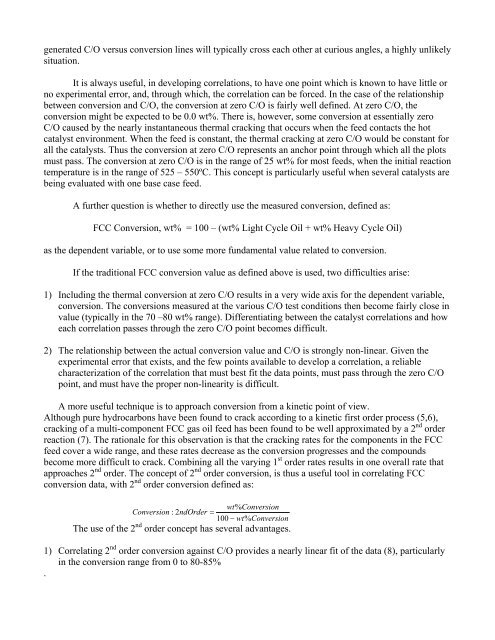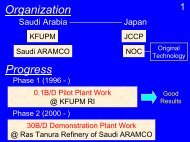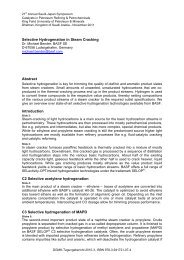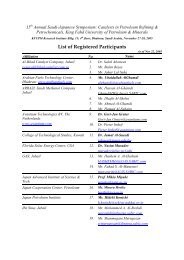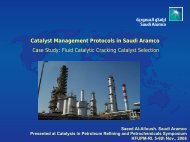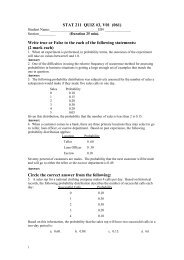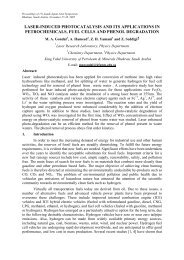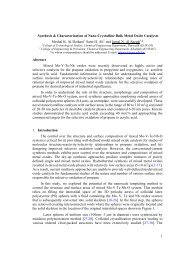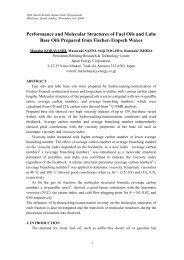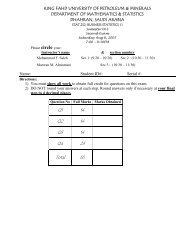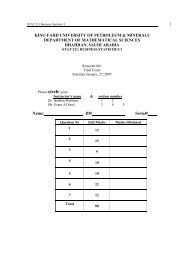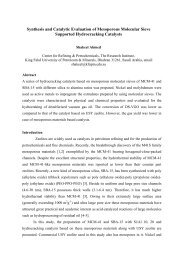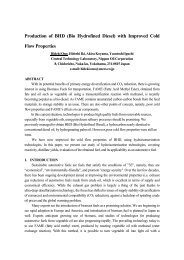The Art of Evaluating Laboratory Fixed Bed Catalytic Cracking Data
The Art of Evaluating Laboratory Fixed Bed Catalytic Cracking Data
The Art of Evaluating Laboratory Fixed Bed Catalytic Cracking Data
Create successful ePaper yourself
Turn your PDF publications into a flip-book with our unique Google optimized e-Paper software.
generated C/O versus conversion lines will typically cross each other at curious angles, a highly unlikelysituation.It is always useful, in developing correlations, to have one point which is known to have little orno experimental error, and, through which, the correlation can be forced. In the case <strong>of</strong> the relationshipbetween conversion and C/O, the conversion at zero C/O is fairly well defined. At zero C/O, theconversion might be expected to be 0.0 wt%. <strong>The</strong>re is, however, some conversion at essentially zeroC/O caused by the nearly instantaneous thermal cracking that occurs when the feed contacts the hotcatalyst environment. When the feed is constant, the thermal cracking at zero C/O would be constant forall the catalysts. Thus the conversion at zero C/O represents an anchor point through which all the plotsmust pass. <strong>The</strong> conversion at zero C/O is in the range <strong>of</strong> 25 wt% for most feeds, when the initial reactiontemperature is in the range <strong>of</strong> 525 – 550ºC. This concept is particularly useful when several catalysts arebeing evaluated with one base case feed.A further question is whether to directly use the measured conversion, defined as:FCC Conversion, wt% = 100 – (wt% Light Cycle Oil + wt% Heavy Cycle Oil)as the dependent variable, or to use some more fundamental value related to conversion.If the traditional FCC conversion value as defined above is used, two difficulties arise:1) Including the thermal conversion at zero C/O results in a very wide axis for the dependent variable,conversion. <strong>The</strong> conversions measured at the various C/O test conditions then become fairly close invalue (typically in the 70 –80 wt% range). Differentiating between the catalyst correlations and howeach correlation passes through the zero C/O point becomes difficult.2) <strong>The</strong> relationship between the actual conversion value and C/O is strongly non-linear. Given theexperimental error that exists, and the few points available to develop a correlation, a reliablecharacterization <strong>of</strong> the correlation that must best fit the data points, must pass through the zero C/Opoint, and must have the proper non-linearity is difficult.A more useful technique is to approach conversion from a kinetic point <strong>of</strong> view.Although pure hydrocarbons have been found to crack according to a kinetic first order process (5,6),cracking <strong>of</strong> a multi-component FCC gas oil feed has been found to be well approximated by a 2 nd orderreaction (7). <strong>The</strong> rationale for this observation is that the cracking rates for the components in the FCCfeed cover a wide range, and these rates decrease as the conversion progresses and the compoundsbecome more difficult to crack. Combining all the varying 1 st order rates results in one overall rate thatapproaches 2 nd order. <strong>The</strong> concept <strong>of</strong> 2 nd order conversion, is thus a useful tool in correlating FCCconversion data, with 2 nd order conversion defined as:wt%ConversionConversion : 2ndOrder=100 − wt%Conversion<strong>The</strong> use <strong>of</strong> the 2 nd order concept has several advantages.1) Correlating 2 nd order conversion against C/O provides a nearly linear fit <strong>of</strong> the data (8), particularlyin the conversion range from 0 to 80-85%.


